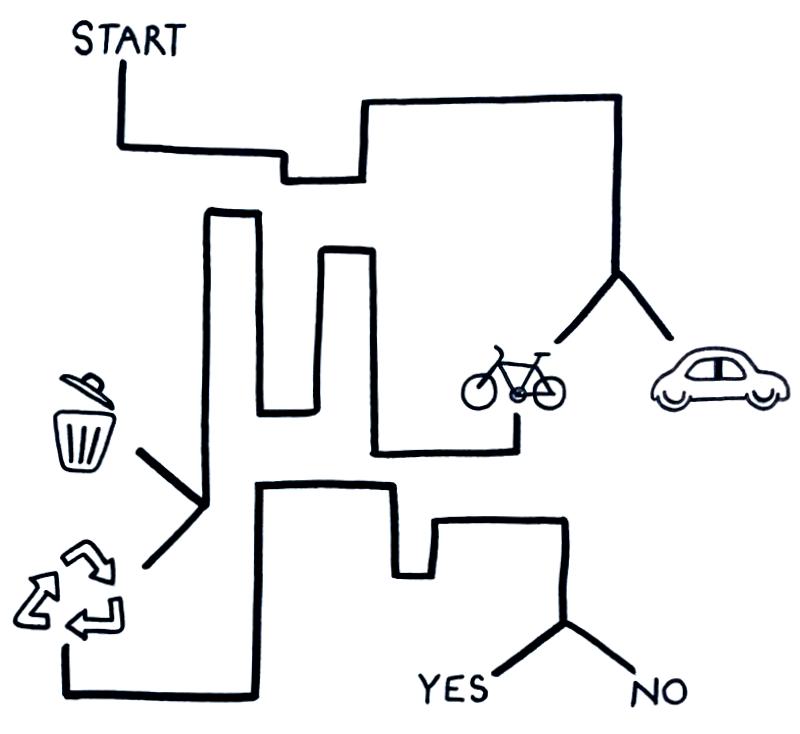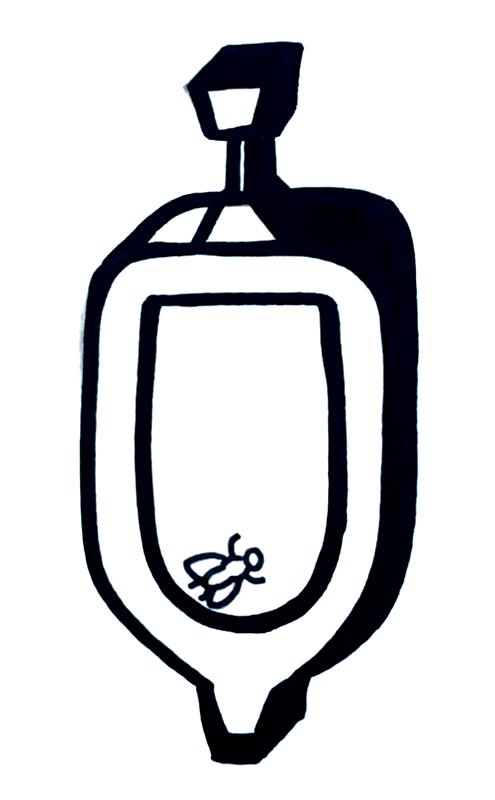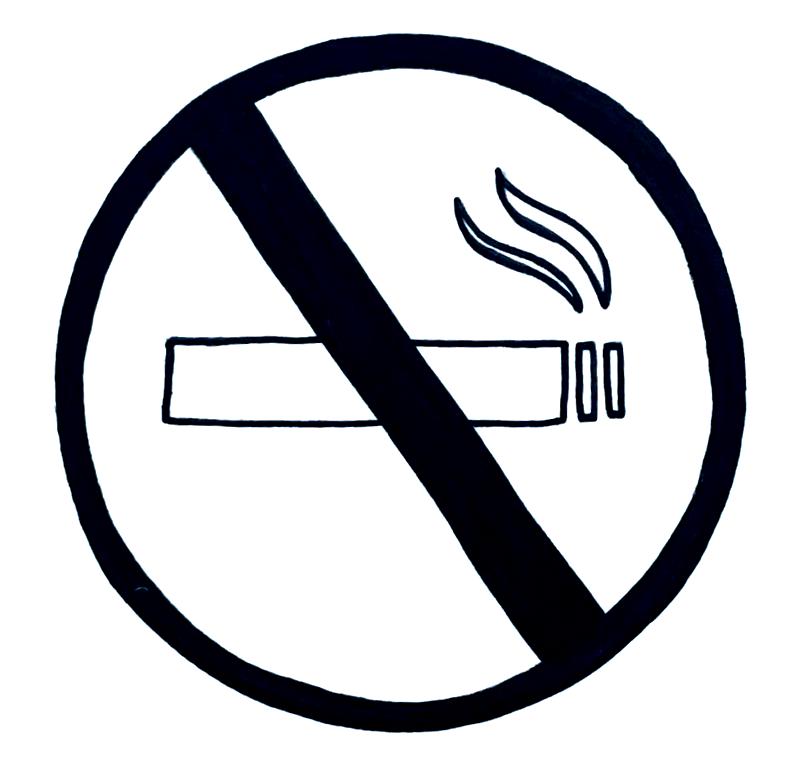Nudging:
Designing behaviour change

It’s either…or
Decision making means choosing between alternative courses of action.
Let’s quickly throw a glance at the sorts of decisions one might commonly face in life:
We can choose to either snack an apple or a candy, to buy organic or conventional food, to ride a bike or a car, to vote for a pro-European or for a Euro-sceptic party, to quit or to continue smoking… or simply to reply yes or no.
Admittedly, this is just a random set of binary questions you may have (or haven’t) come across in your life. Note however that each question involves deciding between one option that is regarded as more beneficial (+) for society (and for you) and one that is less so (-). Of course, in reality most decisions are not black or white, they come in multiple shades of grey.
What these illustrative decisions shed light on though, is THE fundamental challenge of human behaviour in society:
If it is generally agreed that some options or behaviours are clearly more beneficial for society (for the common good) than others, how do you render these options/behaviours attractive to the individual?
How do you make people prefer these options over alternatives?
And ultimately: if people’s current behaviours have detrimental long term effects (on themselves and/or on the planet), how do you make them change their behaviours?
Pay your fair share
It is no secret we live in a world governed by inequality: not everyone on planet is endowed with access to the same resources (in terms of economic, social, cultural and information capital…). As a result, not everyone starts out with the same ‘choice set’.
In that sense, holding those who lack real alternatives disproportionately accountable for the negative consequences of their choices would simply not be fair. On the flip side of the coin, this means that better placed people, companies, societies and nations can be expected to shoulder a greater share of responsibility.
Designing behaviour change
Now, this is where nudging comes into play.
In English language the expression ‘to nudge someone’ means “to lightly push or poke someone”. Speaking metaphorically, nudging theory is about “softly pushing” someone in a desired direction, towards a desired behaviour.
In simple words, nudging theory is concerned with changing how we behave, with subtly shifting our behaviour in a desired direction. It does so by encouraging us to make decisions that are in the best interest of society and ultimately also in our best interest.
|
Comes in handy to know Nudging theory was invented by two US – scientists: by Richard Thaler, Professor in Behavioural Economics at the University of Chicago and by Cass Sunstein, Law Professor at Harvard Law School. In 2017, Richard Thaler was awarded the Nobel Prize in economics for his ground-breaking findings. |
In brief: how does it work?
For any given decision, nudging first looks at ‘the choice architecture’. In other words: how are options currently presented to us? And what influence does the current configuration of choices have on our decisions? Why do we prefer some options over others?
In a second step, nudging then intervenes by reconfiguring options. By changing the design (or architecture) of choice as a whole, it induces us to pick a desired option and to change our behaviour for the better.
Sounds quite abstract?
Some examples will help clarify.
Make it concrete: be a choice architect
Warnings, leading signs and graphics… all can work as nudges. Here’s a little story to illustrate.
In the early 2000’s Schiphol International Airport in Amsterdam was struggling with severe hygiene problems, inlcuding in men’s restrooms. That was when, in 2009, a nudge was put into place that attracted public attention: A tiny sticker depicting a fly was applied inside pissoirs with the aim of reducing spillages and raising hygiene. Baffling as it sounds, the result was that urinals and toilets were kept 85% cleaner.

The US – manufacturer urinalfly.com advertises the effectiveness of its stickers by hinting at men’s basic instincts to have “something to aim for” (here: a fly) and “some laughs along the way”. Basically, it’s a psychological (and perhaps evolutionary?) thing peculiar to men.😉

Although this sounds like a rather fun application of nudging, it also points to its high effectiveness: a great deal can be achieved with as little as a fly.
Nudging for health and climate
Now, consider a perhaps ‘more serious’ matter: the question of nutrition and ecology, in the context of supermarkets and school cantines. A nudging method with a steering effect on behaviour is: ‘increasing the visibility or the convenience’ of options that have a positive effect on health and climate.
For instance, positioning healthy food at eye level has been shown to induce people to pick healthy options more frequently than otherwise. Similarly, placing green arrows on the floor leading to the fruit and vegetable aisles (as tested in a grocery store in the US), made 9 out of 10 shoppers follow the arrows. The result: sales of fresh produces ‘skyrocketed’. Again, all this does is intervening in the choice architecture.

The credo of this kind of nudge is “make it easy”. For instance: “make it easy and cheaper” for people to carry reusable fabric bags and “make it difficult and more expensive” for people to pick plastic bags.
Commit to quit
Pre-commitment strategies can be effective nudges too. Let’s go back to the problem of self-discipline (setting a goal but then falling short of behaving according to plan). Precommitting to engaging in a certain action – for instance via a smoking cessation programme – tends to reduce procrastination and motivate action.

For instance, in the Philippines, the ‘Green Bank’ offers its customers a special savings account programme named ‘Committed Action To Reduce and End Smoking’ (CARES). (You need to know that smoking is extremely commonplace in the Philippines, despite serious health effects).
The idea is to have smokers (who wish to quit) pay into a monthly savings account the exact amount of money they have spent till that date on cigarettes. After 6 months, participants enrolled in the programme need to undergo a urinary test. If they pass the test, they automatically get all their money back.
The Poverty Action Lab at Massachusetts Institute of Technology (MIT) analysed first results of this programme. They found that opening a CARES savings account increased the chances of quitting smoking by 53%.
Feel free to choose
The key thing to highlight here is that nudging doesn’t intend to compromise our freedom of choice. It doesn’t take away any option from us. It only renders some options more and others less attractive. And, it doesn’t force us into choosing a particular option or behaviour, meaning, it doesn’t involve any coercion or penalty from the state or the law. It basically solely works by encouragement through a “soft poke”.
Key take-aways
Nudges can be a powerful tool for behaviour change, when and because:
⇛ they are often cheap, easy and quick to implement
⇛ they are based on empirical evidence. They can (and should always be) tested via randomised controlled trials
⇛ they leave us free to choose
⇛ they are transparent and can be highly effective
Coming up
I talk in greater detail about how nudging can be used to change behaviour for climate and health.
Stay tuned!🐧
Written and published September 2019
by Jessica
List of references I used in this article:
Bourdieu, P. (1986). The Forms of Capital. In J. Richardson (Ed.), Handbook of Theory and Research for the Sociology of Education (pp. 241-258). New York: Greenwood.
Chu, B. (2017). What is ‘nudge theory’ and why should we care? Explaining Richard Thaler’s Nobel economics prize-winning concept. published on independent.co.uk (9th October 2017).
Giné, X., Karlan, D., and Zinman, J. (2010). “Put Your Money Where Your Butt Is: A Commitment Contract for Smoking Cessation.” American Economic Journal: Applied Economics 2: 213-35.
Moss, M. (2013). Nudged to the Produce Aisle by a Look in the Mirror. published on nytimes.com (27th August 2013).
Sunstein, C. (2014). Nudging: A Very Short Guide, 37 J. Consumer Pol’y 583.
Thaler, R., Sunstein, C. (2008). Nudge. Yale University Press, New Haven.
urinalfly.com
Van Gestel, L.C., Kroese, F.M., De Ridder, D.T.D. (2018). Nudging at the checkout counter – A longitudinal study of the effect of a food repositioning nudge on healthy food choice, Psychology & Health, 33:6, 800-809.
Subscribe to My Newsletter !